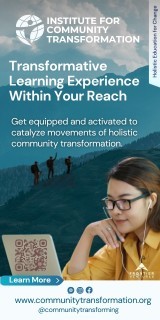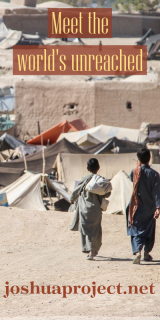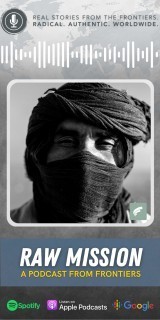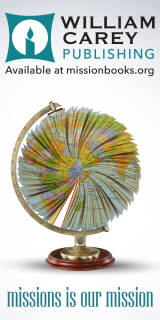Joshua Project 2000 Step 6: Planting Churches In Each Of These Peoples

We have a measurable goal in the Joshua Project 2000 list of least- evangelized peoples. If we stop at identifying, mobilizing, praying or researching, then we fail. The next step is sending teams into each of these peoples for the purpose of church planting.
Spend a few moments to consider the strategies, many involving the national churches, that have been born out of great challenges to the task.
Catch the vision as you ponder the fact that across the globe our Lord is stirring the hearts of a new generation committed to the Great Commission. Church planting in each of the Joshua Project 2000 peoples is possible because of the workers currently being mobilized. Is it possible? Be encouraged as you read about the cracking fortress of Islam that is beginning to tumble down as churches are established in Muslim peoples.
What does it take to plant a church? Join the Task Force for Strategy and Development as they sweat some tough questions to find some answers.
Finally rejoice with the brethren in India for the abundant harvest being reaped as multiple churches are planted there. It can be done!
National AD2000 Initiative by Ross Campbell of New Zealand, Staff Associate for Countrywide Initiatives.
Globally Joshua Project 2000 promises to be the largest cooperative Christian movement in history dedicated to bringing the gospel to the least-evangelized peoples of the world. The commitment internationally of many denominations, mission agencies and churches, the pooling of data and the use of technology in such a specific focus are unprecedented. The project is pregnant with possibilities. Possibilities which will only realize their full potential through the support and involvement of national churches. National churches-- with the exception of a few countries in the 10/40 Window--represent the greatest and, potentially, the most effective resource for reaching the least- evangelized within national and regional borders.
Patrick Johnstone, author of Operation World, states, "There is not a country in the world without a group of Christians, though in some cases they are expatriates who have gone to live there... Christianity is a majority in 149 countries and territories: over 10% in a further 23; over 1% in a further 35. Only in 29 states and territories is Christianity less than 1% of the population."
In the implementation of Joshua Project 2000, the national churches are where "the rubber meets the road." The national churches, regardless of their numerical strength and spiritual vitality, must always be considered an integral part of any focus on least- evangelized peoples within its national boundaries. Least-evangelized peoples within a country are primarily the responsibility of the national churches. Furthermore, as churches are established within least-evangelized peoples, they become part of the larger Christian fellowship of the Body of Christ. Therefore global initiatives must partner and integrate with the national churches if Joshua Project 2000 is to realize its full potential.
What Is a National AD2000 Initiative? It is a bold undertaking by national church leaders to respond to the Great Commission mandate, in a unique opportunity at the close of the millennium, to mobilize the Body of Christ in a nation to complete the unfinished task of evangelization in their own country and make a significant contribution to world evangelization by 2000 AD and beyond.
National AD2000 Initiatives are characterized by two basic purposes: (1) To prioritize the penetration of every significant ethno- linguistic people in its own country and/or the 10/40 Window through the establishment of a pioneer church-planting movement. (2) To ultimately plant a Biblical congregation of believers within practical and cultural distance of every person in every class and kind of people in the nation and beyond.
Basic Components Many nations already have National AD2000 Initiatives, and with the impetus resulting from the Global Consultation on World Evangelization in May, it is anticipated that the majority of countries which do not have their own national plans soon will. While national leaders will define the focus and form of the initiative as they respond to local realities, it is anticipated that National Initiatives will have the following basic components found in current working models:
- Leadership. A visionary, pro-active servant leader or leaders.
- Organizational Structure. A national committee or committees representing the Body of Christ in the nation and having the least- evangelized peoples and unfinished task in its own country and/or the 10/40 Window as its primary focus.
- Goals. Clearly defined and measurable goals with respect to: (a) The establishment, as a priority and minimum, of a pioneer church planting movement within every significant ethno-linguistic people in the nation and/or the 10/40 Window by December 2000. (Note the expectation is that countries outside the 10/40 Window will adopt and focus significant resources on least-evangelized ethno-linguistic peoples in the 10/40 Window.) (b) The establishment of a saturation church-planting movement in the country by December 1996 and every people group by December 2000 leading ultimately to the establishment of a congregation of believers within practical and cultural distance of every person in the nation.
- Initial Assessment. A survey to determine the status of national, regional and world evangelization using the best available information sources.
- Consultations. Primary leaders of all major denominations, mission agencies and Christian ministries gather to consider the completion of the unfinished task in the nation and world.
- Goal Setting and Ownership. Delegations to national consultations individually and collectively consider and commit to specific measurable goals related to: (a) pioneer church planting within the country and/or 10/40 Window; (b) saturation church planting in own country and region.
- Research. An on-going research, analysis and information function to evaluate progress and provide the Body of Christ with accurate, up- to-date information on harvest force and harvest field in the context of national goals and the unfinished task.
- Participation. Commitment to and common goal ownership by a significant number of denominational leaders, pastors, mission agency leaders, ministry executives and the participation of their constituencies in prayer for, outreach to, and support of outreach to least-evangelized peoples, places and classes in the nation and world - especially the 10/40 Window.
- Cooperation. Cooperative relationships with Global AD2000 Resource Networks and with existing movements, networks and structures within the nation that result in coordinated efforts to evangelize the least evangelized in the nation, region and world especially in the 10/40 Window.
- Evaluation. Regular research and analysis monitoring progress toward goals set and the completion of the unfinished task with reports disseminated to all levels of church leadership in seminars, consultations and publications.
- Leadership Development. Leadership development and training related to catalyzing, mobilizing, multiplying and deploying ministry resources to the areas of greatest need.
- United Prayer Efforts. A concerted, extraordinary emphasis on personal and corporate prayer undergirding all aspects of National AD2000 Initiatives. A recognition that the real battle for the least- evangelized peoples, places and nations of the world is in the spiritual realm.
Let us all pray that "as the rubber meets the road" in the national
church initiatives and the increasing numbers of churches and mission agencies involved in Joshua Project 2000, the Spirit of God will continue to move in a mighty way through the Body of Christ, focusing us more than ever before on the Great Commission mandate. By God's power and might, so much has already been done! The remaining task is increasingly visible and within our grasp should we put ourselves before Him to do it. May it be so.
Mobilizing New Missionaries for Nearly 2000 Least- Evangelized Peoples by Pari Rickard, coordinator, with George Verwer, chairman, of the Mobilizing New Missionaries Network
South Africa is one real hot spot in the world of mobilizing new missionaries and AD2000 interest today. Just in the last six months, an astounding clarion call for world evangelization has gone forth with more than 10,000 people in attendance at several missions conferences across this wondrous land. Amazingly, more than 2000 people have risen to some version of that famous challenge -- "who will go for us" with a resounding "here am I, send me!" And this is the repeated story across the world. God is calling out a new army of workers for least-evangelized peoples.
Latin Americans from countries such as Mexico, Dominican Republic, Guatemala, Puerto Rico, Nicaragua, and Cuba are standing in thousands to proceed on to the mission field. The South Americans -- with both the power-house churches of Brazil and Argentina and the smaller, but just as committed, national churches of the south -- are showing the same missions fervor and commitment to go to the 10/40 Window. In fact, Brazil in 1997 will host "Belo Horizonte '97" and thousands of committed Latin American church leaders are expected to participate. Latin America is fully expecting to mobilize tens of thousands of "new missionary recruits" for the 10/40 Window.
In African and Asian national churches, the cry for "more workers for the harvest field" is so widely spread that mobilization events for missions have drawn as many as 70,000 (Korea, 1995) with increasingly direct commitment to missions. Thus, the Holy Spirit seems to be calling out a whole new committed mission force from around the world. With surprising speed, global, national and local church partnerships for least- evangelized peoples are fast becoming the way forward. God is birthing a missions mobilization movement that is not North American, African, Asian, Latin American, South American, European or Australian--it's just Christian and global!
2000 Clear Targets Now in Sight Joshua Project 2000 becomes a "road map" that points the way to the peoples of greatest need for the placement of workers among these least-evangelized peoples. The target list of nearly 2,000 specific peoples--among which most are found in the 10/40 Window--are less than five percent evangelical Christian and have a population of ten thousand or more. So, Joshua Project 2000 is invaluable for naming the peoples that are clear candidates for pioneer cross-cultural missionary efforts, tent-making, and for the establishment of indigenous churches. . 2000 Targets Must Become 2000 Pathways George Verwer pointed out recently that the problem is not the lack of people willing to go to the 10/40 Window. Scores respond at university and local church missions conferences from Latin America, South America, Africa, Asia and the West, clearly indicating a desire to go to the mission field. But will they ever make it?
Verwer said, "It is NOT the lack of people, it is the lack of clear PATHWAYS and the lack of money to send and support them! We could field thousands if there was a way in to the 'Window' and a way to keep them there. We must see thousands of serious sending churches stand with this new mission force if the job will ever be done."
The catalyzation of missionary mobilization efforts and movements in every nation and tens of thousands of local churches around the world is one of the key efforts of the Mobilizing New Missionaries Network. It seems that God is calling missionaries FOR every nation out FROM every nation as well. At the Global Consultation on World Evangelization conference in Korea this year, it was more than staggering to meet the AD2000 Mobilizing New Missionaries coordinators from Mongolia, Ethiopia and Nepal (among other nations)! God is mobilizing the nations around the world. But that is only part of the issue.
A most fundamental question becomes, "Where do I go in the 10/40 Window and How do I get in there?" In other words, what are the pathways into the "Window" that a Latino, African, Asian, Australian or, for that matter, a Westerner, can take to get in?
With the publishing of the Joshua Project 2000 list, the nearly 2000 targeted least-evangelized peoples become clear pathways of service for a "new missionary force." Since denominations, local churches and mission agencies can now clearly and confidently use this list for adoption and prayer for the neediest least-evangelized peoples, the next step is to provide direct pathways of missions service among these peoples.
A main effort of the AD2000 Mobilizing New Missionaries Network is mapping out and publishing opportunities and pathways to growing national missionary mobilization movements, local churches, mission organizations and denominations.
Pathways Must Become Doorways As a new generation of Christians from around the world is mobilized into missions, and as information spreads about the growing number of opportunities into the 10/40 Window, unity and partnership within the Body of Christ is absolutely crucial to reach these peoples. Nearly 2000 target peoples must have paths and doorways identified for service that anyone from any nation can enter.
In one Asian nation with a large Muslim population which contained one of the nearly 2000 peoples identified in Joshua Project 2000, a target people became a pathway, and a pathway became a doorway. Focused prayer for this Muslim people had been going on for years, to the point that a number of churches had adopted this group with a real commitment to prayer, giving and sending workers. But there were no real ways into this people group and there were fewer than fifty believers. Then the first breakthrough came and the target people became a pathway.
A non-residential missionary was offered a miraculous pathway into this group with the "tent-making" offer of over 100 job opportunities - a clear path that could open the doorway for people from a variety of nations, denominations and organizations.
The second breakthrough came in the power of unity for the sake of this people. Over 100 individuals from 18 nations and 13 different denominations and organizations swelled the ranks to join teams to go to this Muslim people. They learned the language and, while working in various secular capacities, helped establish fellowships among these Muslims.
Radically, it was as though unity tipped the spiritual scales in this group. In just three short years, after a doorway was opened, the number of believers has grown from approximately 50 to over 1,100, and several small fellowships have been established. Perhaps this church will one day send missionaries to other neighboring Muslim peoples.
The need is for targets to become paths which, in turn, become the doors into and among the nearly 2000 peoples. That is what the AD2000 Mobilizing New Missionaries Network is about and what we work toward in the future. God is increasingly mobilizing the Church into missions. We are committed to facilitating that mobilization and placement for the sake of the nearly 2000. It is possible. It certainly is needed.
A Church for Every Muslim People? by Greg and Evan Livingstone AD2000 Muslim Task Force
The last fifteen years of pioneer church-planting efforts in Muslim countries indicate that it is both much more fruitful and much more costly than most church leaders have supposed. However, the angels are leaping and praising as Muslims leave the kingdom of darkness and become worshippers in the Kingdom of the Lord Jesus. From Morocco to Mindanao, house churches of Muslim background believers are becoming a reality.
Take Kazakhstan, for example. In a town in this Central Asia nation, over fifty Uighurs have become Christ-followers this year. A 20-year- old girl introduced her mother, grandmother and several brothers, aunts, uncles and cousins to the Lord Jesus. Only the girl's father held out. On a Saturday morning in May, eighteen new believers were publicly baptized. Men wept openly. As the father watched the baptism, he too broke down. Imagine the joy as her father repented and was baptized with the rest of his family!
Why are so many Muslims becoming Christians in Kazakhstan? How in only five years could new workers, inexperienced in Muslim ministry, establish a church of 450 believers, including several cell groups of former Muslims?
Could it be that the Lord of the Harvest is making His move in the Muslim world? It seems He is working despite us, but chooses not to build His church without us.
Training Church Planters by Jane Overstreet and Dr. James Engel, coordinators of the AD2000 Task Force for Strategy and Resource Development
"What kind of churches do you want to plant?" It was a simple question that sparked a flow of responses from the floor. At the end of the list of tremendous qualifications, we asked one more simple question.
"Is this what your current churches look like?" A stunned silence followed, then one after another of the Ghanaian church leaders shook their heads sadly. We were conducting seminars across Africa this summer following up on the recent Global Consultation on World Evangelization, with the goal of introducing our educational resources for Christian leaders. These tools are specifically designed to help Christian leaders in the Two-Thirds World learn strategic thinking skills in order to meet the new goals they have set for themselves of planting churches among the least evangelized within their regions of the world.
"What will it take to plant these ideal churches among the least evangelized, if your current churches don't even meet these standards?"
An even livelier discussion followed as we looked at some of the hard issues of discipleship, poverty, sickness, social justice and the backdoor exodus of new converts, and how each affects the challenge of church planting among the least evangelized.
While the Task Force for Strategy and Resource Development does not claim to hold the answers to all these hard issues of planting churches, we do hope to serve those involved by providing training tools that will help them find their own answers. We serve a creative God, who we believe has, and will provide, all we need to carry out His purposes.
Church Planting In India by John DeVries, President of Mission 21 India
On the Joshua Project 2000 list of peoples, the country of India contains the largest number of peoples needing a church. Mission 21 India, the Bible League and India Bible Literature have formed a partnership with the goal of motivating, training and equipping the national churches of India to systematically and measurably saturate India with 1,000 new house churches per million people. This program began in 1985 with the implementation of IBL's School of Evangelism program, a year-long, full-time, trimester training program for national church planters.
Between 1985 and 1992, two thousand Indian nationals graduated from the training. Of these, 960 were personally surveyed in 1993 to determine the continuing level of activity in the years subsequent to graduation. Each graduate trained an average of twelve apprentice church planters and, through their own efforts and the efforts of those whom they had trained, each was responsible for planting an average of fifty Witnessing Prayer Cells or House Churches. Extrapolated over the 2,000 graduates, this average projects a total of 100,000 new believers groups formed during the period of 1985-1992. Most of this was recorded in the two southern states of Andra Pradesh and Tamil Nadu.
Schools of evangelism have operated in the majority of the states of India. The three organizations are now targeting the northern states with the training program. They expect to have approximately 1,000 students in the year-long training during 1996.
The church planting training relies on a mix of prayer, evangelism, Scripture distribution, children's Bible schools and adult literacy projects. In order to be accepted in the church- planting training program, the applicant must have a least-evangelized people as his or her target area. All peoples reached by the students during their year of training are on record with the three organizations. However, the peoples reached subsequent to the year of training have not been recorded, but the information would be available through survey.
The harvest in India, as it is around the world, is moving at an unprecedented rate!







comments